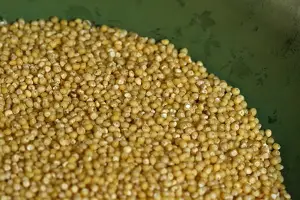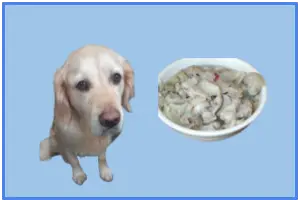
Today I want to talk about millet.
Millet is an ancient food.
It is actually a type of grass and cereal.
First eaten by humans over 7000 years ago when people started to settle and live in one place instead of moving around hunting and gathering.
And it remains a staple crop of many different parts of the world where the conditions are hot and very dry- such as sub Saharan Africa.
Humans may have been eating it for thousands of years but what about our dogs?
Can dogs have millet?
The good news is that dogs can eat millet.
Millet contains nothing that is toxic to dogs.
It is a widely available grain that is easy to prepare but is very expensive to buy.
Nutritionally it is very healthy because it is low in calories and is a great source of vitamins and minerals.
Millet is one of a number of healthy grains that you might also consider feeding your dog.
Grains such as bulgur wheat and quinoa.
But why is millet considered healthy?
We will find out in the next section as we look at its nutrition…
What is the nutrition in millet?
Millet is rich in a whole variety of vitamins and minerals.
The values below are for a 100g portion of millet.
| Calories | 119 |
| Fat | 1g |
| Sodium | 2mg |
| Total Carbohydrate | 24g |
| Fiber | 1.3g |
| Sugar | .1g |
| Protein | 3.5g |
So the chart above shows some of the most important nutrition categories for millet.
And with millet you have a food that has very low values in most of the important categories- overall calories, fat, sodium and sugar.
Now millet is 24% carbohydrates, a figure which you might think is high.
Brown rice has a very similar amount of carbohydrates in it (24%), whilst white rice has 28%.
Potatoes by the way have about 18% carbohydrates.
What vitamins does millet contain?
Millet is a great source of B vitamins for your dog.
Now there are several different B vitamins, but millet has lots of thiamin, riboflavin, niacin and vitamin B6.
And there are many fundamental ways that B vitamins can help your dog.
These include helping to turn food into energy (which is also called metabolism), strengthening the immune system and helping in the creation and maintenance of healthy blood cells.
Having looked at vitamins I want to next move onto minerals.
What minerals does millet contain?
Millet contains bumper amounts of copper, magnesium, manganese and phosphorus.
But how does this help your dog?
Copper helps to create red blood cells which if you remember is also one of the roles of the B vitamins.
Magnesium helps keep a dog’s muscles and their nerves healthy.
Manganese (a little known mineral) helps keep a dog’s bones and tissues healthy.
And lastly phosphorus is fundamental to the health of your dog’s bones and their teeth!
Does millet have any other health benefits for your dog?
Millet is a food that keeps on giving!
Apart from those very specific benefits mentioned above, millet will also help to boost your dog’s health in more general ways.
Firstly, millet is a low glycemic food, which means that it takes the body longer to digest than other foods- such as wheat flour.
Foods that take longer to digest will help to keep your dog’s blood sugar levels more even and far less likely to “spike”.
Secondly (and carrying on with the theme of digestion) millet contains some prebiotics which are good bacteria that will stay in your dog’s gut and help fight infections.
Having looked in quite some depth at all the different health benefits that adding millet to your dog’s diet could have, I now want to take a quick look at some alternatives.
Millet vs bulgur vs quinoa vs barley
How does millet stack up against the competition?
And by that I mean bulgur, quinoa and barley.
They are all pretty specialised foods to be honest.
Although most of us have heard of them, very few of us will keep any of them as staples in our kitchen cupboards.
Are any of them easy to get hold of at a reasonable price?
Well, let’s start there.
Using walmart.com as a reference, I have found the following prices:
All of these four grains are available from walmart.com.
They are available in different size packs and most of them have organic versions of them.
Now to try and do a fair price comparison, I tried to look at products from one manufacturer that were of a similar size.
And to make it easy on the eyes I have created a simple chart for you- which you can see below.
All of these grains are sold by the Bob’s Red Mill brand and they all come in similar sized packs 26 oz.
It was a real struggle to find non organic quinoa….
And I have added brown rice to the list- just as a cheeky comparison.
After all, it is far more likely that we would have this “healthy grain” in our cupboards….
| Millet 28 oz | $16 |
| Bulgur 28 oz | $18 |
| Quinoa 25 oz | $9 |
| Barley 30 oz | $11.91 |
| Brown rice 32 oz | $1.41 |
And these samples suggest to me that millet is a more expensive grain- only beaten on price by bulgur.
In contrast quinoa and barley are far more reasonably priced- barley is almost half the price of millet.
And millet is well over 10 times as expensive as brown rice.
Next up, I want to look at the nutrition in these different grains.
Do they differ in any major ways?
Let’s take a look..
| Millet | Bulgur | Quinoa | Barley | Brown Rice | |
| Calories | 119 | 83 | 120 | 123 | 123 |
| Fat | 1g | .2g | 1.9g | .4g | 1g |
| Sodium | 2mg | 5mg | 7mg | 3mg | 4mg |
| Total Carbs | 24g | 19g | 21g | 28g | 26g |
| Fiber | 1.3g | 4.5g | 2.8g | 3.8g | 1.6g |
| Sugar | .1g | .1g | .9g | .3g | .2g |
| Protein | 3.5g | 3.1g | 4.4g | 2.3g | 2.7g |
Across most of the major nutrition values, I would have to say that there are no huge differences.
And that includes brown rice which we know is far more reasonably priced and more widely available.
Although the most expensive food (bulgur) has got some impressively healthy figures…
With regard to millet, quinoa and barley the biggest difference seems to be in the amount of carbohydrates that each grain contains but even then the gap isn’t that big.
How much millet should I feed to my dog?
Let’s be honest here.
It would be very difficult to give your dog too much millet.
The worst that could happen if your dog snatched a bowl of millet whilst non one was looking or ate a packet of uncooked millet that was left on the counter, would be a bad case of diarrhea or vomiting for a few hours.
Or your dog might just not feel like moving for a few hours because they are so full!
In terms of the portion sizes that you want to give your dog deliberately, then we are talking a few tablespoons for each meal.
For a small dog you might want to limit it to a couple of teaspoons.
Most of us are feeding our dog’s a complete diet with the kibble or the canned food that they eat.
They don’t need anything else.
Anything else that we do give them should be considered as an optional extra and be given in very limited portions.
Even healthy foods.
Unless a vet has advised you otherwise.
Can I feed millet to my dog everyday?
Yes, you can feed your dog millet everyday if your wallet is deep enough.
Would I recommend it?
No, not really.
I think that it would be good for any dog to be given a wide range of foods.
If you like the idea of boosting your dog’s health, give them some millet everyday for a week and then the next week let them try a bit of brown rice.
The following week you could try adding a few bits of a dark green vegetable such as kale.
What is the best way of preparing millet for your dog?
Although it is the fastest and easiest way to prepare millet, I don’t recommend that you give it to them raw.
Just because it will be that much harder for your dog to digest.
Instead cook it in water, similar to how you would cook rice.
Add millet to boiled water and then simmer it for about 15 minutes.
Let it sit for about 5 or 10 minutes and then it will be cool enough to serve to your dog.
Photo Credits
¹ Photo by Steven Jackson on Flickr





